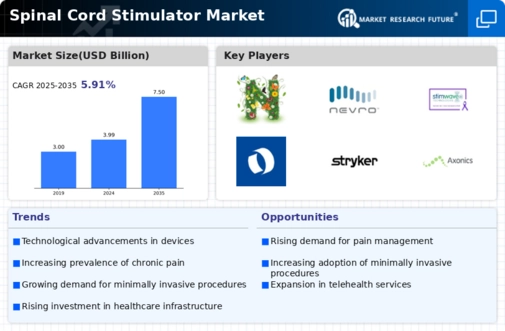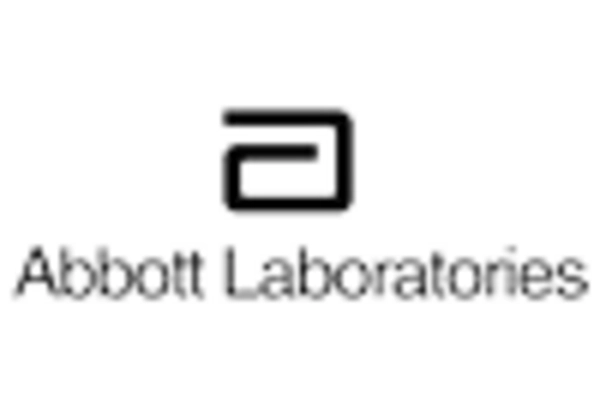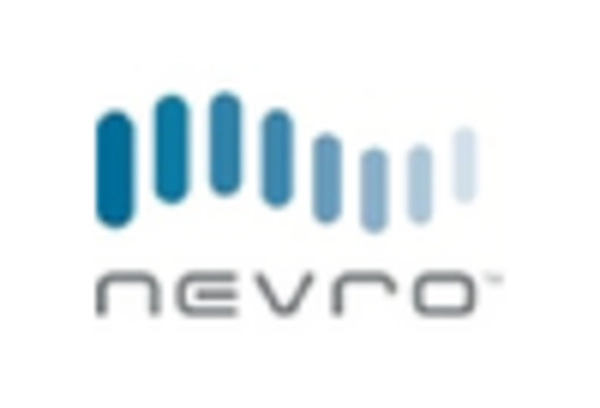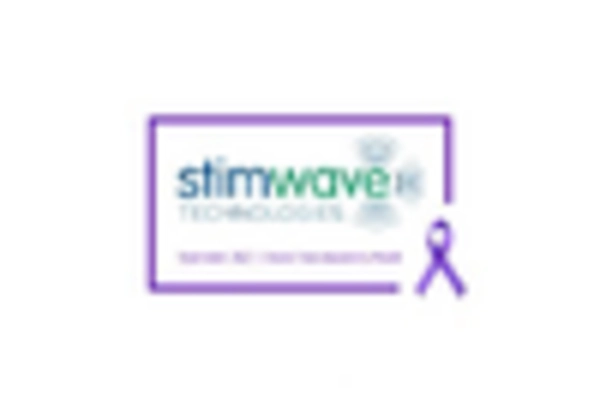Non-Implantable
Implantable
Rechargeable
Non-Rechargeable
Chronic Pain Management
Neuropathic Pain
Decompression Syndrome
Failed Back Surgery Syndrome
Hospitals
Ambulatory Surgical Centers
Pain Management Clinics
Home Care Settings
Conventional Spinal Cord Stimulators
Burst Spinal Cord Stimulators
High-Frequency Spinal Cord Stimulators
North America
Europe
South America
Asia Pacific
Middle East and Africa
North America Outlook (USD Billion, 2019-2035)
North America Spinal Cord Stimulator Market by Type
Non-Implantable
Implantable
Rechargeable
Non-Rechargeable
North America Spinal Cord Stimulator Market by Application Type
Chronic Pain Management
Neuropathic Pain
Decompression Syndrome
Failed Back Surgery Syndrome
North America Spinal Cord Stimulator Market by End User Type
Hospitals
Ambulatory Surgical Centers
Pain Management Clinics
Home Care Settings
North America Spinal Cord Stimulator Market by Technology Type
Conventional Spinal Cord Stimulators
Burst Spinal Cord Stimulators
High-Frequency Spinal Cord Stimulators
North America Spinal Cord Stimulator Market by Regional Type
US
Canada
US Outlook (USD Billion, 2019-2035)
US Spinal Cord Stimulator Market by Type
Non-Implantable
Implantable
Rechargeable
Non-Rechargeable
US Spinal Cord Stimulator Market by Application Type
Chronic Pain Management
Neuropathic Pain
Decompression Syndrome
Failed Back Surgery Syndrome
US Spinal Cord Stimulator Market by End User Type
Hospitals
Ambulatory Surgical Centers
Pain Management Clinics
Home Care Settings
US Spinal Cord Stimulator Market by Technology Type
Conventional Spinal Cord Stimulators
Burst Spinal Cord Stimulators
High-Frequency Spinal Cord Stimulators
CANADA Outlook (USD Billion, 2019-2035)
CANADA Spinal Cord Stimulator Market by Type
Non-Implantable
Implantable
Rechargeable
Non-Rechargeable
CANADA Spinal Cord Stimulator Market by Application Type
Chronic Pain Management
Neuropathic Pain
Decompression Syndrome
Failed Back Surgery Syndrome
CANADA Spinal Cord Stimulator Market by End User Type
Hospitals
Ambulatory Surgical Centers
Pain Management Clinics
Home Care Settings
CANADA Spinal Cord Stimulator Market by Technology Type
Conventional Spinal Cord Stimulators
Burst Spinal Cord Stimulators
High-Frequency Spinal Cord Stimulators
Europe Outlook (USD Billion, 2019-2035)
Europe Spinal Cord Stimulator Market by Type
Non-Implantable
Implantable
Rechargeable
Non-Rechargeable
Europe Spinal Cord Stimulator Market by Application Type
Chronic Pain Management
Neuropathic Pain
Decompression Syndrome
Failed Back Surgery Syndrome
Europe Spinal Cord Stimulator Market by End User Type
Hospitals
Ambulatory Surgical Centers
Pain Management Clinics
Home Care Settings
Europe Spinal Cord Stimulator Market by Technology Type
Conventional Spinal Cord Stimulators
Burst Spinal Cord Stimulators
High-Frequency Spinal Cord Stimulators
Europe Spinal Cord Stimulator Market by Regional Type
Germany
UK
France
Russia
Italy
Spain
Rest of Europe
GERMANY Outlook (USD Billion, 2019-2035)
GERMANY Spinal Cord Stimulator Market by Type
Non-Implantable
Implantable
Rechargeable
Non-Rechargeable
GERMANY Spinal Cord Stimulator Market by Application Type
Chronic Pain Management
Neuropathic Pain
Decompression Syndrome
Failed Back Surgery Syndrome
GERMANY Spinal Cord Stimulator Market by End User Type
Hospitals
Ambulatory Surgical Centers
Pain Management Clinics
Home Care Settings
GERMANY Spinal Cord Stimulator Market by Technology Type
Conventional Spinal Cord Stimulators
Burst Spinal Cord Stimulators
High-Frequency Spinal Cord Stimulators
UK Outlook (USD Billion, 2019-2035)
UK Spinal Cord Stimulator Market by Type
Non-Implantable
Implantable
Rechargeable
Non-Rechargeable
UK Spinal Cord Stimulator Market by Application Type
Chronic Pain Management
Neuropathic Pain
Decompression Syndrome
Failed Back Surgery Syndrome
UK Spinal Cord Stimulator Market by End User Type
Hospitals
Ambulatory Surgical Centers
Pain Management Clinics
Home Care Settings
UK Spinal Cord Stimulator Market by Technology Type
Conventional Spinal Cord Stimulators
Burst Spinal Cord Stimulators
High-Frequency Spinal Cord Stimulators
FRANCE Outlook (USD Billion, 2019-2035)
FRANCE Spinal Cord Stimulator Market by Type
Non-Implantable
Implantable
Rechargeable
Non-Rechargeable
FRANCE Spinal Cord Stimulator Market by Application Type
Chronic Pain Management
Neuropathic Pain
Decompression Syndrome
Failed Back Surgery Syndrome
FRANCE Spinal Cord Stimulator Market by End User Type
Hospitals
Ambulatory Surgical Centers
Pain Management Clinics
Home Care Settings
FRANCE Spinal Cord Stimulator Market by Technology Type
Conventional Spinal Cord Stimulators
Burst Spinal Cord Stimulators
High-Frequency Spinal Cord Stimulators
RUSSIA Outlook (USD Billion, 2019-2035)
RUSSIA Spinal Cord Stimulator Market by Type
Non-Implantable
Implantable
Rechargeable
Non-Rechargeable
RUSSIA Spinal Cord Stimulator Market by Application Type
Chronic Pain Management
Neuropathic Pain
Decompression Syndrome
Failed Back Surgery Syndrome
RUSSIA Spinal Cord Stimulator Market by End User Type
Hospitals
Ambulatory Surgical Centers
Pain Management Clinics
Home Care Settings
RUSSIA Spinal Cord Stimulator Market by Technology Type
Conventional Spinal Cord Stimulators
Burst Spinal Cord Stimulators
High-Frequency Spinal Cord Stimulators
ITALY Outlook (USD Billion, 2019-2035)
ITALY Spinal Cord Stimulator Market by Type
Non-Implantable
Implantable
Rechargeable
Non-Rechargeable
ITALY Spinal Cord Stimulator Market by Application Type
Chronic Pain Management
Neuropathic Pain
Decompression Syndrome
Failed Back Surgery Syndrome
ITALY Spinal Cord Stimulator Market by End User Type
Hospitals
Ambulatory Surgical Centers
Pain Management Clinics
Home Care Settings
ITALY Spinal Cord Stimulator Market by Technology Type
Conventional Spinal Cord Stimulators
Burst Spinal Cord Stimulators
High-Frequency Spinal Cord Stimulators
SPAIN Outlook (USD Billion, 2019-2035)
SPAIN Spinal Cord Stimulator Market by Type
Non-Implantable
Implantable
Rechargeable
Non-Rechargeable
SPAIN Spinal Cord Stimulator Market by Application Type
Chronic Pain Management
Neuropathic Pain
Decompression Syndrome
Failed Back Surgery Syndrome
SPAIN Spinal Cord Stimulator Market by End User Type
Hospitals
Ambulatory Surgical Centers
Pain Management Clinics
Home Care Settings
SPAIN Spinal Cord Stimulator Market by Technology Type
Conventional Spinal Cord Stimulators
Burst Spinal Cord Stimulators
High-Frequency Spinal Cord Stimulators
REST OF EUROPE Outlook (USD Billion, 2019-2035)
REST OF EUROPE Spinal Cord Stimulator Market by Type
Non-Implantable
Implantable
Rechargeable
Non-Rechargeable
REST OF EUROPE Spinal Cord Stimulator Market by Application Type
Chronic Pain Management
Neuropathic Pain
Decompression Syndrome
Failed Back Surgery Syndrome
REST OF EUROPE Spinal Cord Stimulator Market by End User Type
Hospitals
Ambulatory Surgical Centers
Pain Management Clinics
Home Care Settings
REST OF EUROPE Spinal Cord Stimulator Market by Technology Type
Conventional Spinal Cord Stimulators
Burst Spinal Cord Stimulators
High-Frequency Spinal Cord Stimulators
APAC Outlook (USD Billion, 2019-2035)
APAC Spinal Cord Stimulator Market by Type
Non-Implantable
Implantable
Rechargeable
Non-Rechargeable
APAC Spinal Cord Stimulator Market by Application Type
Chronic Pain Management
Neuropathic Pain
Decompression Syndrome
Failed Back Surgery Syndrome
APAC Spinal Cord Stimulator Market by End User Type
Hospitals
Ambulatory Surgical Centers
Pain Management Clinics
Home Care Settings
APAC Spinal Cord Stimulator Market by Technology Type
Conventional Spinal Cord Stimulators
Burst Spinal Cord Stimulators
High-Frequency Spinal Cord Stimulators
APAC Spinal Cord Stimulator Market by Regional Type
China
India
Japan
South Korea
Malaysia
Thailand
Indonesia
Rest of APAC
CHINA Outlook (USD Billion, 2019-2035)
CHINA Spinal Cord Stimulator Market by Type
Non-Implantable
Implantable
Rechargeable
Non-Rechargeable
CHINA Spinal Cord Stimulator Market by Application Type
Chronic Pain Management
Neuropathic Pain
Decompression Syndrome
Failed Back Surgery Syndrome
CHINA Spinal Cord Stimulator Market by End User Type
Hospitals
Ambulatory Surgical Centers
Pain Management Clinics
Home Care Settings
CHINA Spinal Cord Stimulator Market by Technology Type
Conventional Spinal Cord Stimulators
Burst Spinal Cord Stimulators
High-Frequency Spinal Cord Stimulators
INDIA Outlook (USD Billion, 2019-2035)
INDIA Spinal Cord Stimulator Market by Type
Non-Implantable
Implantable
Rechargeable
Non-Rechargeable
INDIA Spinal Cord Stimulator Market by Application Type
Chronic Pain Management
Neuropathic Pain
Decompression Syndrome
Failed Back Surgery Syndrome
INDIA Spinal Cord Stimulator Market by End User Type
Hospitals
Ambulatory Surgical Centers
Pain Management Clinics
Home Care Settings
INDIA Spinal Cord Stimulator Market by Technology Type
Conventional Spinal Cord Stimulators
Burst Spinal Cord Stimulators
High-Frequency Spinal Cord Stimulators
JAPAN Outlook (USD Billion, 2019-2035)
JAPAN Spinal Cord Stimulator Market by Type
Non-Implantable
Implantable
Rechargeable
Non-Rechargeable
JAPAN Spinal Cord Stimulator Market by Application Type
Chronic Pain Management
Neuropathic Pain
Decompression Syndrome
Failed Back Surgery Syndrome
JAPAN Spinal Cord Stimulator Market by End User Type
Hospitals
Ambulatory Surgical Centers
Pain Management Clinics
Home Care Settings
JAPAN Spinal Cord Stimulator Market by Technology Type
Conventional Spinal Cord Stimulators
Burst Spinal Cord Stimulators
High-Frequency Spinal Cord Stimulators
SOUTH KOREA Outlook (USD Billion, 2019-2035)
SOUTH KOREA Spinal Cord Stimulator Market by Type
Non-Implantable
Implantable
Rechargeable
Non-Rechargeable
SOUTH KOREA Spinal Cord Stimulator Market by Application Type
Chronic Pain Management
Neuropathic Pain
Decompression Syndrome
Failed Back Surgery Syndrome
SOUTH KOREA Spinal Cord Stimulator Market by End User Type
Hospitals
Ambulatory Surgical Centers
Pain Management Clinics
Home Care Settings
SOUTH KOREA Spinal Cord Stimulator Market by Technology Type
Conventional Spinal Cord Stimulators
Burst Spinal Cord Stimulators
High-Frequency Spinal Cord Stimulators
MALAYSIA Outlook (USD Billion, 2019-2035)
MALAYSIA Spinal Cord Stimulator Market by Type
Non-Implantable
Implantable
Rechargeable
Non-Rechargeable
MALAYSIA Spinal Cord Stimulator Market by Application Type
Chronic Pain Management
Neuropathic Pain
Decompression Syndrome
Failed Back Surgery Syndrome
MALAYSIA Spinal Cord Stimulator Market by End User Type
Hospitals
Ambulatory Surgical Centers
Pain Management Clinics
Home Care Settings
MALAYSIA Spinal Cord Stimulator Market by Technology Type
Conventional Spinal Cord Stimulators
Burst Spinal Cord Stimulators
High-Frequency Spinal Cord Stimulators
THAILAND Outlook (USD Billion, 2019-2035)
THAILAND Spinal Cord Stimulator Market by Type
Non-Implantable
Implantable
Rechargeable
Non-Rechargeable
THAILAND Spinal Cord Stimulator Market by Application Type
Chronic Pain Management
Neuropathic Pain
Decompression Syndrome
Failed Back Surgery Syndrome
THAILAND Spinal Cord Stimulator Market by End User Type
Hospitals
Ambulatory Surgical Centers
Pain Management Clinics
Home Care Settings
THAILAND Spinal Cord Stimulator Market by Technology Type
Conventional Spinal Cord Stimulators
Burst Spinal Cord Stimulators
High-Frequency Spinal Cord Stimulators
INDONESIA Outlook (USD Billion, 2019-2035)
INDONESIA Spinal Cord Stimulator Market by Type
Non-Implantable
Implantable
Rechargeable
Non-Rechargeable
INDONESIA Spinal Cord Stimulator Market by Application Type
Chronic Pain Management
Neuropathic Pain
Decompression Syndrome
Failed Back Surgery Syndrome
INDONESIA Spinal Cord Stimulator Market by End User Type
Hospitals
Ambulatory Surgical Centers
Pain Management Clinics
Home Care Settings
INDONESIA Spinal Cord Stimulator Market by Technology Type
Conventional Spinal Cord Stimulators
Burst Spinal Cord Stimulators
High-Frequency Spinal Cord Stimulators
REST OF APAC Outlook (USD Billion, 2019-2035)
REST OF APAC Spinal Cord Stimulator Market by Type
Non-Implantable
Implantable
Rechargeable
Non-Rechargeable
REST OF APAC Spinal Cord Stimulator Market by Application Type
Chronic Pain Management
Neuropathic Pain
Decompression Syndrome
Failed Back Surgery Syndrome
REST OF APAC Spinal Cord Stimulator Market by End User Type
Hospitals
Ambulatory Surgical Centers
Pain Management Clinics
Home Care Settings
REST OF APAC Spinal Cord Stimulator Market by Technology Type
Conventional Spinal Cord Stimulators
Burst Spinal Cord Stimulators
High-Frequency Spinal Cord Stimulators
South America Outlook (USD Billion, 2019-2035)
South America Spinal Cord Stimulator Market by Type
Non-Implantable
Implantable
Rechargeable
Non-Rechargeable
South America Spinal Cord Stimulator Market by Application Type
Chronic Pain Management
Neuropathic Pain
Decompression Syndrome
Failed Back Surgery Syndrome
South America Spinal Cord Stimulator Market by End User Type
Hospitals
Ambulatory Surgical Centers
Pain Management Clinics
Home Care Settings
South America Spinal Cord Stimulator Market by Technology Type
Conventional Spinal Cord Stimulators
Burst Spinal Cord Stimulators
High-Frequency Spinal Cord Stimulators
South America Spinal Cord Stimulator Market by Regional Type
Brazil
Mexico
Argentina
Rest of South America
BRAZIL Outlook (USD Billion, 2019-2035)
BRAZIL Spinal Cord Stimulator Market by Type
Non-Implantable
Implantable
Rechargeable
Non-Rechargeable
BRAZIL Spinal Cord Stimulator Market by Application Type
Chronic Pain Management
Neuropathic Pain
Decompression Syndrome
Failed Back Surgery Syndrome
BRAZIL Spinal Cord Stimulator Market by End User Type
Hospitals
Ambulatory Surgical Centers
Pain Management Clinics
Home Care Settings
BRAZIL Spinal Cord Stimulator Market by Technology Type
Conventional Spinal Cord Stimulators
Burst Spinal Cord Stimulators
High-Frequency Spinal Cord Stimulators
MEXICO Outlook (USD Billion, 2019-2035)
MEXICO Spinal Cord Stimulator Market by Type
Non-Implantable
Implantable
Rechargeable
Non-Rechargeable
MEXICO Spinal Cord Stimulator Market by Application Type
Chronic Pain Management
Neuropathic Pain
Decompression Syndrome
Failed Back Surgery Syndrome
MEXICO Spinal Cord Stimulator Market by End User Type
Hospitals
Ambulatory Surgical Centers
Pain Management Clinics
Home Care Settings
MEXICO Spinal Cord Stimulator Market by Technology Type
Conventional Spinal Cord Stimulators
Burst Spinal Cord Stimulators
High-Frequency Spinal Cord Stimulators
ARGENTINA Outlook (USD Billion, 2019-2035)
ARGENTINA Spinal Cord Stimulator Market by Type
Non-Implantable
Implantable
Rechargeable
Non-Rechargeable
ARGENTINA Spinal Cord Stimulator Market by Application Type
Chronic Pain Management
Neuropathic Pain
Decompression Syndrome
Failed Back Surgery Syndrome
ARGENTINA Spinal Cord Stimulator Market by End User Type
Hospitals
Ambulatory Surgical Centers
Pain Management Clinics
Home Care Settings
ARGENTINA Spinal Cord Stimulator Market by Technology Type
Conventional Spinal Cord Stimulators
Burst Spinal Cord Stimulators
High-Frequency Spinal Cord Stimulators
REST OF SOUTH AMERICA Outlook (USD Billion, 2019-2035)
REST OF SOUTH AMERICA Spinal Cord Stimulator Market by Type
Non-Implantable
Implantable
Rechargeable
Non-Rechargeable
REST OF SOUTH AMERICA Spinal Cord Stimulator Market by Application Type
Chronic Pain Management
Neuropathic Pain
Decompression Syndrome
Failed Back Surgery Syndrome
REST OF SOUTH AMERICA Spinal Cord Stimulator Market by End User Type
Hospitals
Ambulatory Surgical Centers
Pain Management Clinics
Home Care Settings
REST OF SOUTH AMERICA Spinal Cord Stimulator Market by Technology Type
Conventional Spinal Cord Stimulators
Burst Spinal Cord Stimulators
High-Frequency Spinal Cord Stimulators
MEA Outlook (USD Billion, 2019-2035)
MEA Spinal Cord Stimulator Market by Type
Non-Implantable
Implantable
Rechargeable
Non-Rechargeable
MEA Spinal Cord Stimulator Market by Application Type
Chronic Pain Management
Neuropathic Pain
Decompression Syndrome
Failed Back Surgery Syndrome
MEA Spinal Cord Stimulator Market by End User Type
Hospitals
Ambulatory Surgical Centers
Pain Management Clinics
Home Care Settings
MEA Spinal Cord Stimulator Market by Technology Type
Conventional Spinal Cord Stimulators
Burst Spinal Cord Stimulators
High-Frequency Spinal Cord Stimulators
MEA Spinal Cord Stimulator Market by Regional Type
GCC Countries
South Africa
Rest of MEA
GCC COUNTRIES Outlook (USD Billion, 2019-2035)
GCC COUNTRIES Spinal Cord Stimulator Market by Type
Non-Implantable
Implantable
Rechargeable
Non-Rechargeable
GCC COUNTRIES Spinal Cord Stimulator Market by Application Type
Chronic Pain Management
Neuropathic Pain
Decompression Syndrome
Failed Back Surgery Syndrome
GCC COUNTRIES Spinal Cord Stimulator Market by End User Type
Hospitals
Ambulatory Surgical Centers
Pain Management Clinics
Home Care Settings
GCC COUNTRIES Spinal Cord Stimulator Market by Technology Type
Conventional Spinal Cord Stimulators
Burst Spinal Cord Stimulators
High-Frequency Spinal Cord Stimulators
SOUTH AFRICA Outlook (USD Billion, 2019-2035)
SOUTH AFRICA Spinal Cord Stimulator Market by Type
Non-Implantable
Implantable
Rechargeable
Non-Rechargeable
SOUTH AFRICA Spinal Cord Stimulator Market by Application Type
Chronic Pain Management
Neuropathic Pain
Decompression Syndrome
Failed Back Surgery Syndrome
SOUTH AFRICA Spinal Cord Stimulator Market by End User Type
Hospitals
Ambulatory Surgical Centers
Pain Management Clinics
Home Care Settings
SOUTH AFRICA Spinal Cord Stimulator Market by Technology Type
Conventional Spinal Cord Stimulators
Burst Spinal Cord Stimulators
High-Frequency Spinal Cord Stimulators
REST OF MEA Outlook (USD Billion, 2019-2035)
REST OF MEA Spinal Cord Stimulator Market by Type
Non-Implantable
Implantable
Rechargeable
Non-Rechargeable
REST OF MEA Spinal Cord Stimulator Market by Application Type
Chronic Pain Management
Neuropathic Pain
Decompression Syndrome
Failed Back Surgery Syndrome
REST OF MEA Spinal Cord Stimulator Market by End User Type
Hospitals
Ambulatory Surgical Centers
Pain Management Clinics
Home Care Settings
REST OF MEA Spinal Cord Stimulator Market by Technology Type
Conventional Spinal Cord Stimulators
Burst Spinal Cord Stimulators
High-Frequency Spinal Cord Stimulators

















Leave a Comment